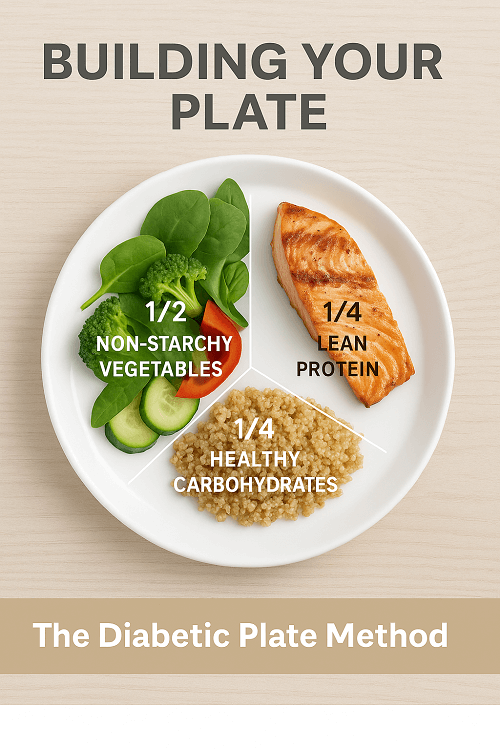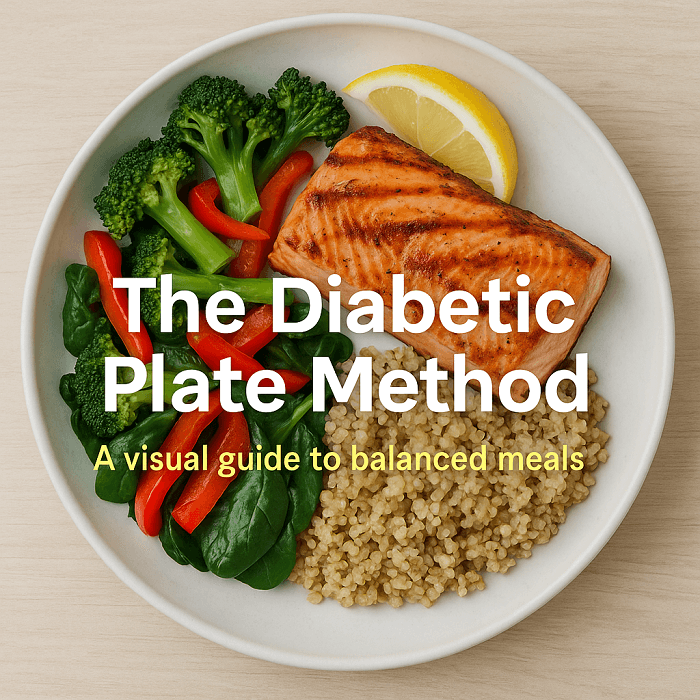Understanding and applying The Diabetic Plate Method is a powerful and simple way for people with diabetes to build balanced, blood sugar–friendly meals. This visual approach to meal planning helps reduce guesswork and supports healthier eating habits.
In this article, you’ll learn:
• What The Diabetic Plate Method is
• Why it works for people managing diabetes
• How to assemble balanced plates with visuals
• Sample meals for everyday use
• Tools, common mistakes, and tips to stay consistent
Let’s break it down—one plate at a time.
🔒 Disclaimer
This article is for informational purposes only and does not constitute medical advice. Always consult a certified diabetes educator, registered dietitian, or your healthcare provider before making dietary changes, especially in managing diabetes.
What is The Diabetic Plate Method?
The Diabetic Plate Method is a simplified meal-planning approach designed for people with diabetes to balance carbohydrates, proteins, and non-starchy vegetables. Instead of complex carb counting, it uses visual cues—half the plate veggies, a quarter lean protein, a quarter starchy food—to guide portion control and nutrient balance.
🔍 Key Principles:
-
Half the Plate = Non-starchy vegetables (e.g., leafy greens, peppers, broccoli)—full of fiber and low in carbs.
-
One-Quarter of the Plate = Lean protein (e.g., chicken, fish, tofu)—stabilizes blood sugar and supports muscle health.
-
One-Quarter of the Plate = Healthy carbohydrates (e.g., whole grains, starchy vegetables)—for energy with portion control.
-
Optional Side = A small serving of fruit or dairy.
-
Healthy Fat = A drizzle of olive oil or a few nuts/seeds.
This method simplifies meal decisions and supports steady glucose management by controlling carbohydrate intake intuitively—with The Diabetic Plate Method guiding every meal.
Why The Diabetic Plate Method Works
1. Blood Glucose Control
Dividing your plate this way limits carbohydrate intake and avoids sharp post-meal blood sugar spikes .
2. Fiber & Satiety
Non-starchy vegetables add bulk and fiber, helping you feel full without extra calories or carbs .
3. Balanced Macronutrients
Combining protein and healthy fats slows digestion and helps stabilize blood sugar throughout the afternoon.
4. Simplicity & Consistency
Instead of complex numbers, you follow a “visual plate”—easy to remember and repeat daily.
Visual Guide to The Diabetic Plate Method
[Visual Placeholder]
Imagine a standard round dinner plate:
-
🥗 Left half: Mixed vegetables (spinach, peppers, broccoli)
-
🐟 Top right quarter: Grilled salmon or chicken breast
-
🌾 Bottom right quarter: Cooked quinoa or sweet potato
-
🥣 Side plate/cup: A small piece of fruit or ½-cup Greek yogurt

How to Build Your Plate Using The Diabetic Plate Method
Step 1: Fill Half Your Plate with Non-Starchy Vegetables
Why it matters:
In the Diabetic Plate Method, non-starchy vegetables should take up half your plate. These foods are naturally low in carbohydrates and high in fiber, helping you feel full without spiking blood glucose levels.
Examples:
-
Leafy greens (spinach, kale, arugula)
-
Broccoli and cauliflower
-
Bell peppers, cucumbers, tomatoes
-
Mushrooms and zucchini
📌 According to the American Diabetes Association (ADA), these vegetables should be a cornerstone of every diabetic-friendly meal.
Visual Tip:
Half a standard 9-inch plate = about 1 to 2 cups of raw or cooked vegetables.
Step 2: Add One-Quarter of Lean Protein
Why it’s important:
The Diabetic Plate Method emphasizes protein because it slows digestion, stabilizes blood sugar, and promotes satiety. Including lean protein at every meal can help prevent energy crashes and overeating.
Examples of lean proteins:
-
Grilled chicken or turkey
-
Baked or grilled fish (e.g., salmon, cod, tuna)
-
Tofu or tempeh
-
Eggs
-
Low-fat cottage cheese
✅ According to Harvard T.H. Chan School of Public Health, quality protein is vital for muscle maintenance and long-term metabolic health.
Visual Tip:
One-quarter of your plate = about 3–4 ounces of cooked protein, or the size of your palm.
Step 3: Reserve One-Quarter for Healthy Carbohydrates
Why balance is key:
In the Diabetic Plate Method, the final quarter of the plate is reserved for carbohydrates—but not all carbs are created equal. Focus on complex, fiber-rich carbs that are slowly digested and won’t cause rapid blood sugar spikes.
Smart carb options:
-
Cooked quinoa or brown rice (½ cup)
-
Baked sweet potato (½ medium)
-
Lentils or chickpeas (¼ to ½ cup)
-
Whole wheat pasta or barley
-
Corn or green peas
These choices align with guidelines from the Mayo Clinic for healthy carb intake in diabetes nutrition.
Optional: Add Fruit, Dairy, or Healthy Fats
To make your meal more complete, the Diabetic Plate Method allows for small, controlled portions of:
-
Fruit: Half an apple or ½ cup fresh berries
-
Dairy: ½ cup plain Greek yogurt or a glass of skim milk
-
Healthy fats: 1 tablespoon olive oil, ¼ avocado, or a few almonds
💡 Healthy fats can support heart health, which is especially important for people with diabetes.
Visual Recap of The Diabetic Plate Method
Here’s how a properly balanced plate should look using the Diabetic Plate Method:
| Section | Portion | Example Foods |
|---|---|---|
| ½ Plate | Non-starchy veggies | Spinach, broccoli, zucchini |
| ¼ Plate | Lean protein | Grilled salmon, chicken breast |
| ¼ Plate | Complex carbs | Quinoa, sweet potato, lentils |
| Optional Side | Fruit/Dairy/Healthy Fat | Blueberries, Greek yogurt, olive oil |
This visual approach makes it easy to assemble meals that are nutritious, satisfying, and diabetes-friendly—without calorie counting or carb confusion.
Sample Meals Using The Diabetic Plate Method
Following the Diabetic Plate Method doesn’t mean eating bland food or following a rigid routine. Below are sample meals for breakfast, lunch, and dinner that balance nutrition and taste, while keeping blood sugar in check.
✅ Breakfast Plate
-
½ Plate Non-Starchy Veggies: Sautéed spinach and cherry tomatoes
-
¼ Plate Lean Protein: 2 scrambled eggs
-
¼ Plate Healthy Carb: ½ cup cooked steel-cut oats (unsweetened)
-
Optional Side: ½ cup blueberries + black coffee
💡 Tip: For extra flavor and heart health, add 1 tsp olive oil to the veggies.
✅ Lunch Plate
-
½ Plate Non-Starchy Veggies: Mixed greens with cucumbers, radish, carrots
-
¼ Plate Lean Protein: Grilled chicken breast
-
¼ Plate Healthy Carb: ½ cup quinoa
-
Optional Side: 1 tablespoon vinaigrette dressing + lemon water
🔗 Related: What to Eat with Type 2 Diabetes: A Beginner’s Nutrition Guide
✅ Dinner Plate
-
½ Plate Non-Starchy Veggies: Roasted cauliflower and green beans
-
¼ Plate Lean Protein: Baked salmon
-
¼ Plate Healthy Carb: ½ cup sweet potato mash
-
Optional Side: ¼ avocado slices
📝 Consistency is key. Repeat this pattern with variety across your week to reduce meal planning stress.
Customizing The Diabetic Plate Method for Special Diets
The beauty of the Diabetic Plate Method is that it adapts easily to various dietary preferences or health conditions. Here’s how:
1. Vegetarian Version
-
Protein: Tofu, tempeh, eggs, low-fat cheese, Greek yogurt, or legumes
-
Carbs: Lentils, black beans, edamame, farro
-
Veggies: Same as base plan—focus on high-fiber, colorful vegetables
💡 Example: Grilled tempeh, sautéed kale, ½ cup lentils, and a spoon of hummus
2. Gluten-Free Version
-
Carbs: Use certified gluten-free grains like quinoa, brown rice, or millet
-
Protein: Lean meats, fish, tofu, legumes
-
Watch out: Avoid breaded items, processed meats, or sauces containing gluten
🔗 Learn more from Celiac Disease Foundation
3. Low-Carb/Keto-Inspired Version
-
¼ plate carbs becomes optional — or replaced with extra non-starchy vegetables
-
Focus on: avocado, eggs, fatty fish, leafy greens
-
Include more healthy fats: nuts, seeds, olive oil
⚠️ Important: The keto diet may not be suitable for everyone with diabetes. Always consult your healthcare provider.
💬 A Note on Portion Adjustments
The Diabetic Plate Method is scalable. For people with higher energy needs (e.g., active individuals), portion sizes may be increased—but always proportionally:
-
Still use the plate divisions (½ veggies, ¼ protein, ¼ carbs)
-
Just use larger plates or add nutrient-dense sides like nuts or beans
📌 For weight loss or tighter glucose control, smaller plates or reduced carb portions may be appropriate.
Common Mistakes, Tools for Success, and Final Tips
⚠️ Common Mistakes to Avoid with the Diabetic Plate Method
Even though the Diabetic Plate Method is simple and visual, many people unintentionally make errors that can reduce its effectiveness. Let’s take a look at the most common ones:
❌ Mistake 1: Misjudging Portion Sizes
It’s easy to overestimate or underestimate your portions—especially carbs like rice or pasta.
Fix it:
Use a digital food scale or measuring cups until you become more confident with eyeballing servings.
❌ Mistake 2: Forgetting About Cooking Oils and Sauces
Sauces, salad dressings, and cooking oils can add a significant amount of calories, sugar, and fat—often without you realizing.
Fix it:
-
Read nutrition labels for sugar and carb content in sauces
-
Choose oil sprays or measure 1 tbsp of olive oil max
-
Make your own dressing with lemon, vinegar, or Greek yogurt
❌ Mistake 3: Skipping the Veggies
Some people focus only on carbs and protein, forgetting that non-starchy vegetables should make up half the plate.
Fix it:
Prep veggies ahead of time and roast, grill, or sauté them with herbs to keep them interesting.
❌ Mistake 4: Not Individualizing the Method
The Diabetic Plate Method offers a balanced framework, but one size doesn’t fit all.
Fix it:
Work with a registered dietitian to tailor plate sizes, carb intake, or protein needs to your health goals.
🔗 Academy of Nutrition and Dietetics: Find an RD
Tools to Help You Succeed with the Diabetic Plate Method
Incorporating tech and planning tools can make staying consistent easier:
Apps for Tracking
-
Carb Manager: Great for counting net carbs and logging meals
-
MyPlate Calorie Tracker: Visual tools and portion education
-
Glucose Buddy: Combines blood sugar monitoring with meal logging
Printable Plate Templates
Use printable plate visuals or placemats to remind yourself of proportions while eating. Many are available for free via diabetes organizations.
Grocery Planning Tools
Use a weekly shopping list tailored to the Diabetic Plate Method to make grocery trips faster and healthier.
Consider adding this internal link to support visitors:
7-Day Diabetic Dinner Plan (with Shopping List)
✅ Final Thoughts: Making The Diabetic Plate Method a Lifelong Habit
The Diabetic Plate Method is more than just a meal model—it’s a long-term strategy to manage diabetes without calorie counting or complicated math.
Key benefits include:
-
Helps regulate blood sugar consistently
-
Empowers you to build balanced meals anywhere
-
Reduces food anxiety by creating structure
-
Adapts to all cultural cuisines and eating patterns
📌 Action Steps to Get Started Today
-
Print a visual plate template and place it on your dining table
-
Plan 3 meals this week using the ½-¼-¼ structure
-
Take photos of your plates to stay accountable
-
Join a support group or follow diabetes-friendly recipe blogs
-
Share your meals on social media to inspire others
🔗 Also, explore more diabetes-friendly recipes on RecipesHom.com
🔒 Disclaimer
This article is for educational purposes only and does not constitute medical advice. Always consult your healthcare provider, certified diabetes educator, or registered dietitian before making dietary or lifestyle changes.
💡 By following the Diabetic Plate Method with intention, creativity, and consistency, you’re investing in a future of better blood sugar control and healthier eating—one plate at a time.
